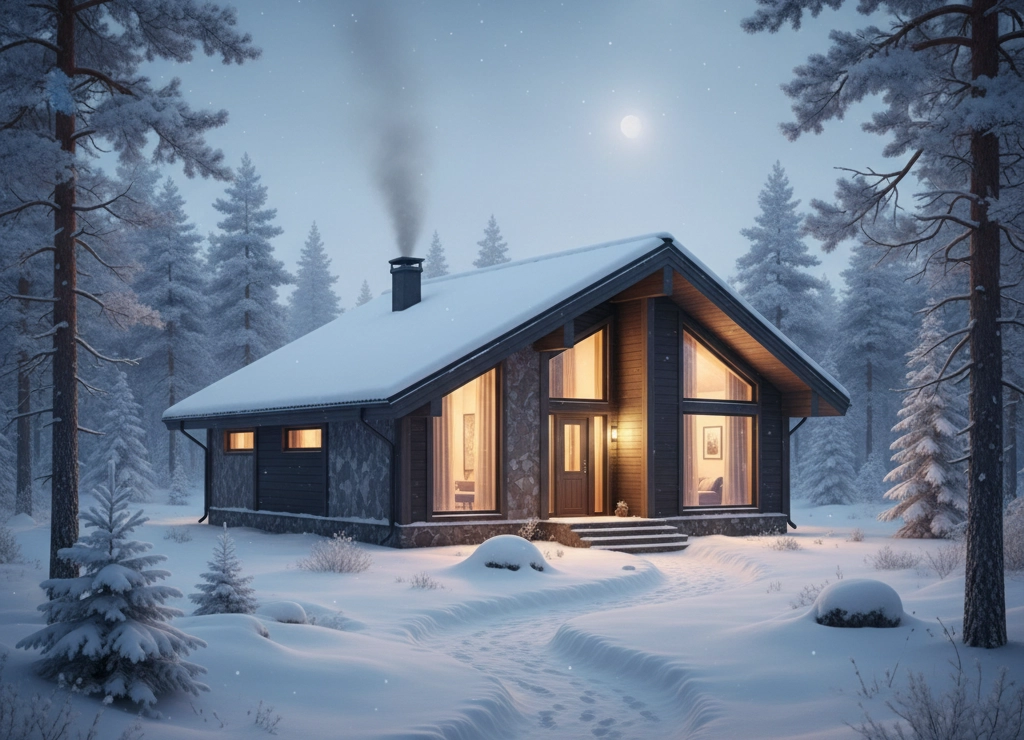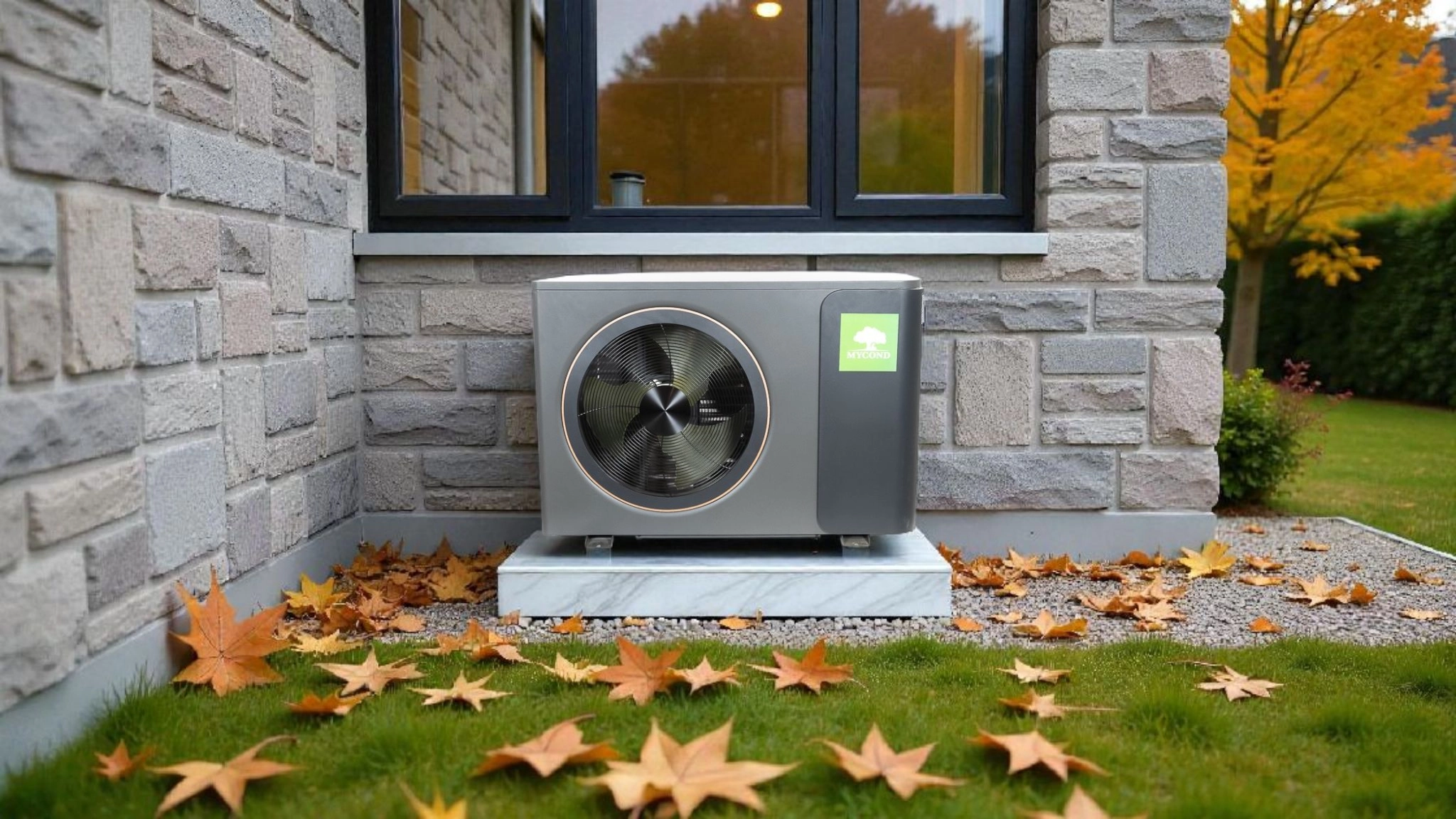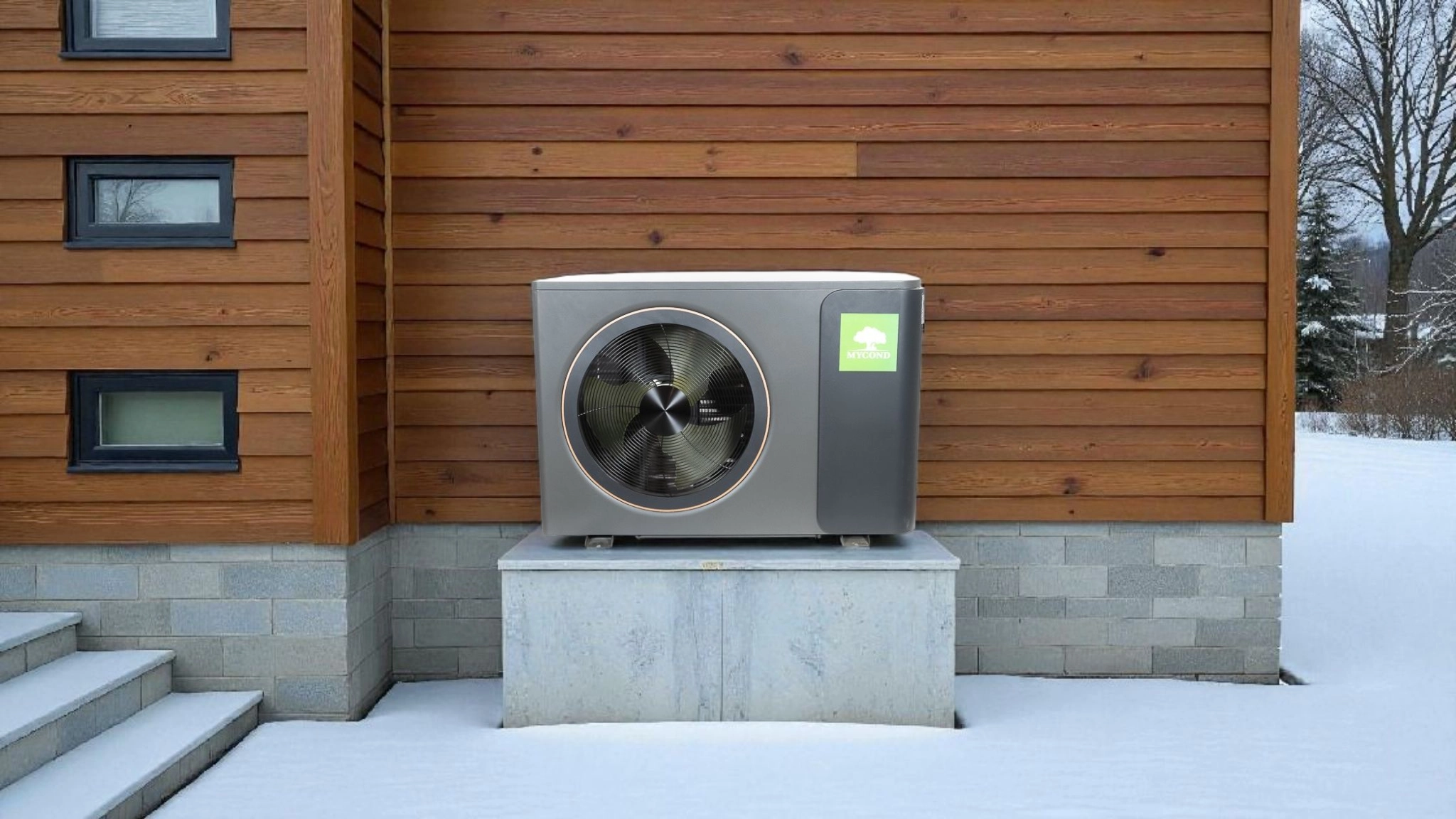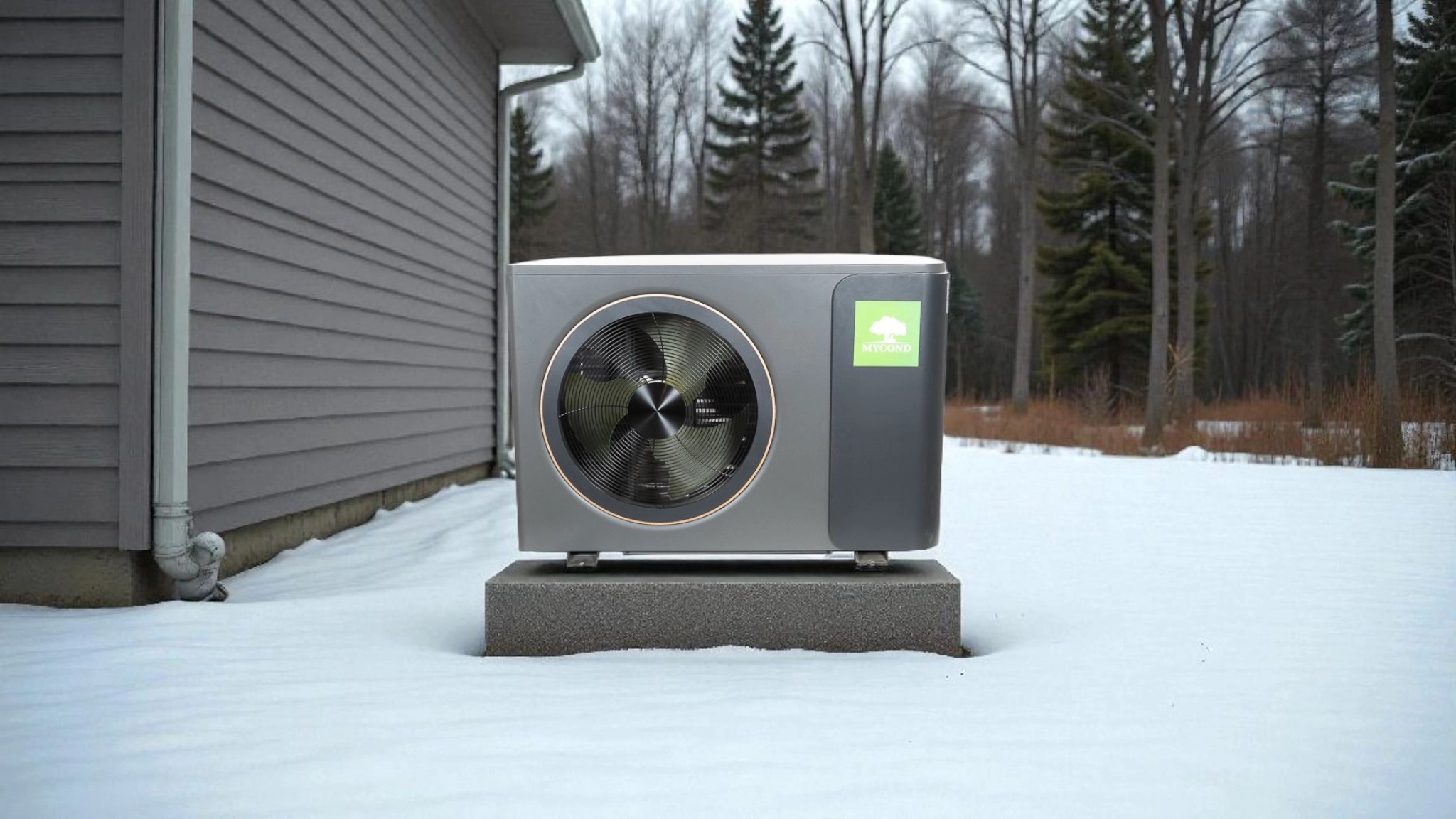
Choosing a heat pump for a 100 m² home is a task thousands of property owners in Europe face every day. However, most of them make typical mistakes that lead either to overpaying for excessive functionality or to purchasing equipment with insufficient capacity. The key problem is focusing solely on floor area rather than the building’s actual heat losses. The Mycond MBasic series was created specifically to solve this problem — it is the optimal solution for owners looking for reliable equipment with sufficient, but not excessive, functionality for residential properties.

Mistake number one — focusing on area instead of heat losses
The query "heat pump for a 100 m² home" is technically incorrect and does not provide enough information for correct equipment selection. Why? Because two houses of the same area can have completely different heat losses depending on:
- Insulation quality
- Number and quality of windows
- Ceiling height
- Climate zone
- Building orientation relative to the cardinal directions
According to European heat loss calculation standards, the following indicators apply to homes with different energy performance:
- New energy-efficient homes: 30–50 W/m²
- Modernized homes with partial insulation: 50–70 W/m²
- Old uninsulated homes: 100–120 W/m²
This means that for a 100 m² house, the range of actual heat losses can vary from 3 to 12 kW! Imagine the difference in the required equipment output in these cases. Choosing a heat pump “by eye,” based only on area, leads to purchasing an oversized or, conversely, an undersized unit.
Mistake number two — choosing unnecessary functionality
Mycond offers three series of heat pumps that differ in functionality and purpose:
- MBasic — with a Zhuhai Landa compressor, output 7.2–11.9 kW, SCOP 4.5–4.65. Designed for private homes up to 150 m² with a simple heating layout.
- BeeSmart — with a Mitsubishi Electric compressor, output 9–19 kW, SCOP 4.72–4.98. For complex systems with cascades and weather-compensation.
- BeeThermic — with a Panasonic EVI compressor, output 6–24 kW, SCOP 4.47–4.58. Operates down to -25°C with EVI technology for stable output in extreme frost.

For a typical 100 m² home, the MBasic series provides an optimal balance of functionality and performance:
- Monoblock design for easy installation
- Inverter technology for smooth power modulation
- Operation down to -25°C
- Supply temperature up to +55°C
- Energy efficiency class A+++
- Heat Pump Keymark certification
- Remote control via the Mycond app
At the same time, MBasic does not include features rarely used in simple private homes: weather-compensation with two circuits, Modbus integration, cascade connection schemes. Key principle of prudence: why pay for features you don’t need?
Mistake number three — mismatched supply temperature
Property owners often overlook that different types of heating terminals require different supply temperatures:
- Old radiators: +50...+60°C
- Fan coils (Fan Coils): +35...+45°C
- Underfloor heating: +30...+40°C
The MBasic heat pump provides a supply temperature up to +55°C, which makes it compatible with most existing heating systems, including old radiators. This is a critical advantage for heating modernization — you don’t need to replace all the radiators, which significantly simplifies the transition to alternative heating.

An additional advantage is using fan coils in combination with the MBasic heat pump. These devices not only operate efficiently at low supply temperatures in winter but can also be used for cooling in summer, ensuring year-round comfort.
Mistake number four — underestimating bivalence
Bivalence point — the outdoor temperature at which the heat pump can no longer cover all the home’s heat losses by itself, and an additional heat source must be switched on. This usually happens during severe frosts.
Heat pump performance depends on outdoor temperature:
- At +7°C — COP = 4.0–4.3
- At -7°C — COP drops to 2.6–2.9
- At -25°C — the heat pump still operates, but with reduced output
For a home with 10–12 kW heat losses, it is more cost-effective to install the MHM-U09HL (9.7 kW) with an additional 3 kW electric heater for peak frosts than to purchase a more powerful model that will operate with low efficiency for most of the season.
Example of calculating the bivalence point for a 100 m² home:
- Heat losses at -15°C: 8 kW
- Heating capacity of MHM-U09HL at -15°C: approximately 5 kW
- Output deficit: 3 kW
- Solution: 3 kW backup electric heater
Mistake number five — no allowance for domestic hot water
When selecting a heat pump, you need to consider not only space heating but also domestic hot water (DHW). The recommended power margin for DHW is 10–20% above the calculated heat losses.
When a hot water cylinder is connected, the system experiences additional load. For example, if the home’s heat losses are 7 kW, the optimal heat pump capacity should be at least 7.7–8.4 kW (7 kW + 10–20%). Therefore, the MHM-U09HL model with 9.7 kW output will be the optimal choice.
It is important to note that the issue of output reduction during defrost cycles is effectively solved by installing a buffer tank that accumulates heat and releases it during defrosting.
How to correctly select MBasic for a 100 m² home — a step-by-step method
- Calculate the actual heat losses according to European standards: area × specific heat losses (30–50 W/m² for new homes, 50–70 W/m² for modernized homes, 100–120 W/m² for old homes).
- Determine the supply temperature required by your heating system: radiators (+50...+60°C), fan coils (+35...+45°C), underfloor heating (+30...+40°C).
- Choose the operating scheme: monovalent (heat pump only) or bivalent (pump + backup source for peak frosts).
- Add a 10–20% margin for domestic hot water.
- Select the appropriate MBasic model:

MBasic models for different types of homes:
- MHM-U06HL: heating capacity 7.2 kW (A7W35), COP 4.3; output 3.6 kW at -7°C, COP 2.6; sound level 64 dBA; power supply 230V/50Hz; class A+++/A++. Recommended for: new energy-efficient homes 100–120 m² with 3–5 kW heat losses, systems with underfloor heating, fan coils, or low-temperature radiators.
- MHM-U09HL: heating capacity 9.7 kW (A7W35), COP 4.0; output 5.7 kW at -7°C, COP 2.7; sound level 67 dBA; power supply 230V/50Hz; class A+++/A++. Recommended for: modernized homes 100–130 m² with 5–8 kW heat losses, combined heating systems. A universal model for most cases.
- MHM-U12HL: heating capacity 11.9 kW (A7W35), COP 4.0; output 6.8 kW at -7°C, COP 2.9; sound level 68 dBA; power supply 230V/50Hz; class A+++/A++. Recommended for: old homes 80–100 m² with 10–12 kW heat losses or modernized homes 120–150 m². A bivalent scheme with a 3–5 kW reserve is mandatory.
Why MBasic is the optimal choice for a 100 m² home
The MBasic series has a set of advantages that make it an ideal choice for a typical private home of 100 m²:
- Sufficient functionality without unnecessary options
- Reliable Zhuhai Landa compressor with an optimal balance of quality and functionality
- High energy efficiency — class A+++ at W35, SCOP up to 4.65
- European certification Heat Pump Keymark
- Monoblock design — simple installation with minimal installation costs
- Operation down to -25°C — sufficient for most European regions
- Supply temperature up to +55°C — can be connected to old radiators
- R32 refrigerant — eco-friendly and efficient
- Remote control via the Mycond app
- Special heat exchanger coating — reduces defrosting costs by 10%

At the same time, MBasic is objectively inferior to the premium BeeSmart and BeeThermic series in some aspects, but for a typical 100 m² home these differences are insignificant:
- No weather-compensated controller with heating curves — for a small home a basic thermostat is sufficient
- No control of two independent circuits — a 100 m² home usually has one heating circuit
- No Modbus integration — required only for commercial facilities
- The Zhuhai Landa compressor has slightly lower SCOP figures (4.5 versus 4.9 for Mitsubishi Electric), but this difference is not critical for a small home
Installation and connection of MBasic
The monoblock design of MBasic offers several installation advantages:
- All components are already in one casing
- No refrigerant lines are required
- Easier to obtain installation permission
- Faster installation
Connection schemes:
- Direct connection — for small systems up to 100 m²
- Through a hydraulic separator — for systems with several circuits
- With a buffer tank — to increase system inertia and protect against frequent cycling
Features of connecting to different heating types:
- Radiators — supply temperature +50...+55°C
- Fan coils — supply temperature +35...+45°C, cooling capability in summer
- Underfloor heating — supply temperature +30...+40°C, maximum COP
Additional comfort is provided by remote control via the Mycond app: system operation monitoring, temperature adjustment, mode switching, error diagnostics, and timer settings.
FAQ — typical questions about selecting a heat pump
Why can’t you select a heat pump based only on a 100 m² area?
Area does not account for insulation quality, ceiling height, number of windows, or the regional climate. A 100 m² home can have heat losses from 3 to 12 kW depending on these factors.
How to calculate a home’s heat losses by yourself?
Multiply the area by the specific heat losses according to European standards: 30–50 W/m² for new homes, 50–70 W/m² for modernized ones, 100–120 W/m² for old uninsulated ones. For an accurate calculation, it is better to order a thermal engineering audit.
What is the bivalence point in simple terms?
It is the outdoor air temperature at which the heat pump can no longer cover all heat losses on its own and a backup heat source must be switched on. It is usually from -5°C to -10°C depending on the model and heat losses.
Is a backup boiler needed for a 100 m² home?
It depends on heat losses and climate. For a well-insulated home with 5–7 kW heat losses in a temperate climate, a single MBasic in a monovalent scheme is sufficient. For an old home with 10–12 kW heat losses, a bivalent scheme MBasic + 3–5 kW electric backup is preferable.
What supply temperature is required for radiators?
Old cast-iron or steel radiators are designed for +70...+90°C from a gas boiler, but with a heat pump they can operate efficiently at +50...+55°C if their surface area is sized correctly. MBasic provides up to +55°C, which is ideal for modernizing existing systems.
Conclusion
Mycond MBasic is the optimal choice for owners of 100 m² homes who are looking for a reliable entry-level heat pump without overpaying for the sophisticated features of premium series. Correct selection is based on three main principles:
- Accurate calculation of the home’s heat losses instead of focusing on area
- Choosing the optimal scheme (monovalent or bivalent) depending on climate zone and insulation quality
- Selecting equipment with sufficient, but not excessive, functionality for real needs
MBasic combines key advantages: energy efficiency class A+++, a reliable Zhuhai Landa compressor, operation down to -25°C, supply temperature up to +55°C, monoblock design, Heat Pump Keymark certification, and all necessary functions for a residential home without redundant options.
Want to select the optimal MBasic model for your home, taking into account actual heat losses and the specifics of your heating system? Contact us via the feedback form — our engineers will provide a free consultation and help calculate the optimal system configuration for your property.
When choosing a heat pump for a 100 m² home, the key factor is calculating the actual heat losses (3–12 kW) and selecting equipment with optimal functionality — the Mycond MBasic series with 7.2–11.9 kW output provides all the necessary features for a private home without overpaying for premium-class extras.